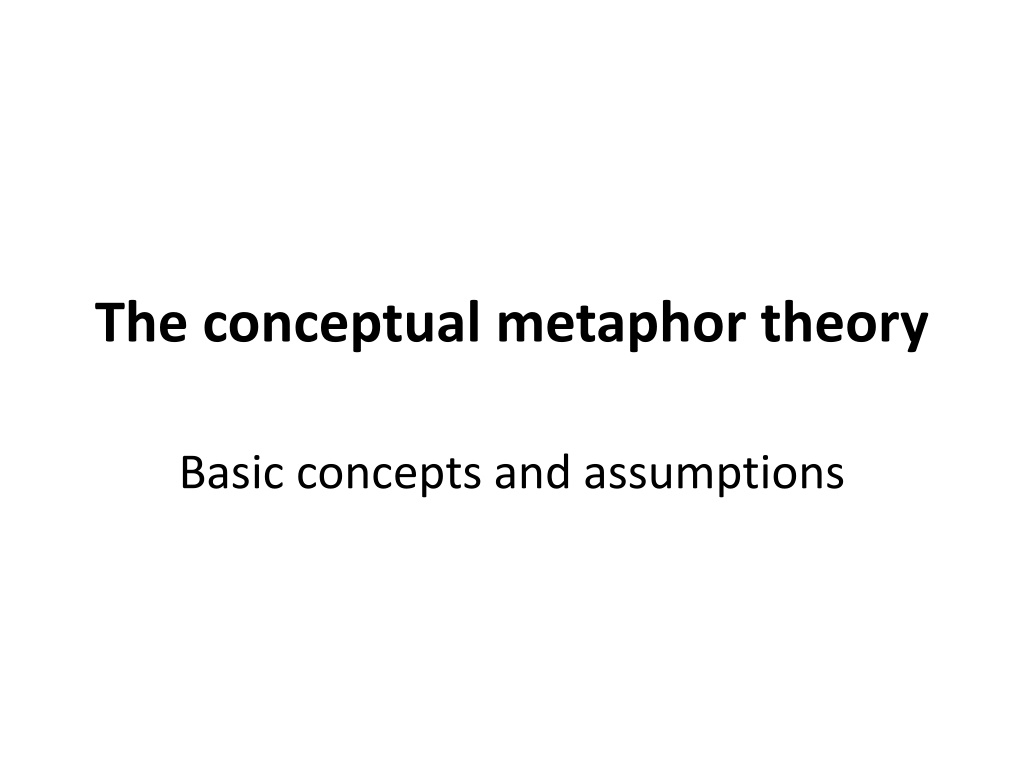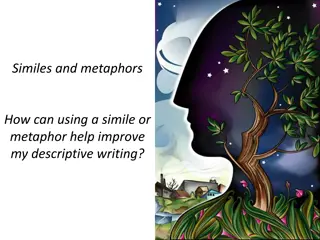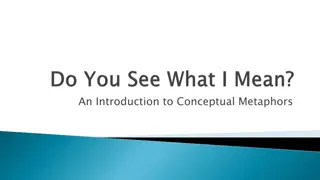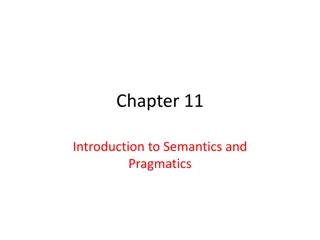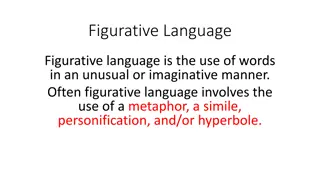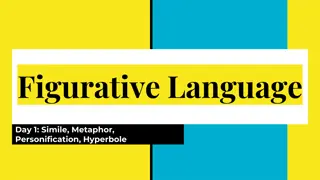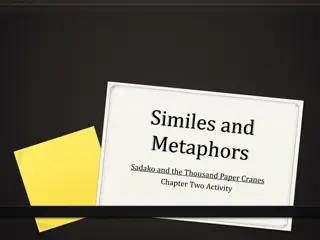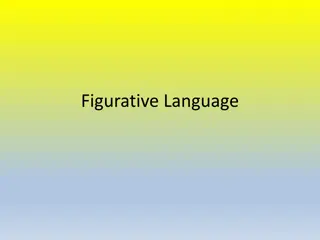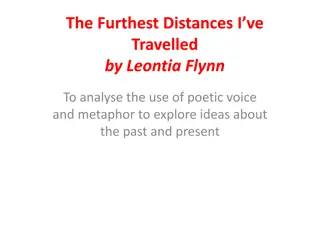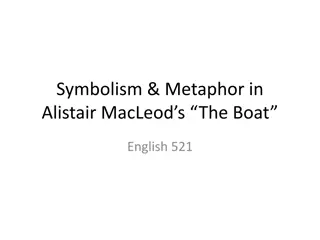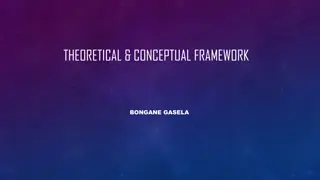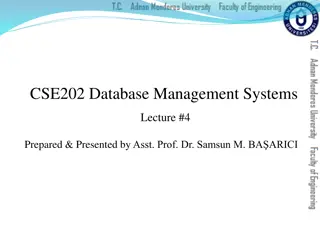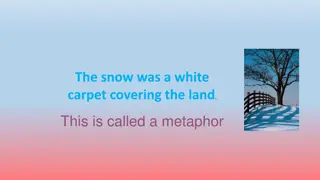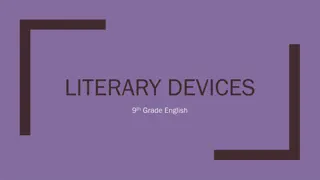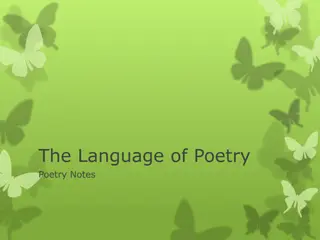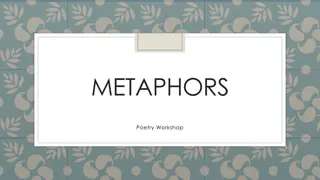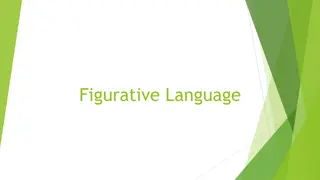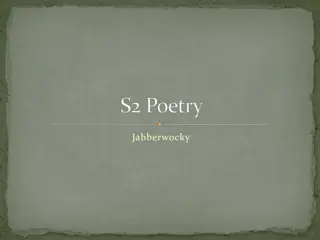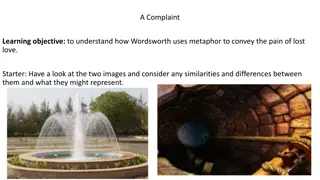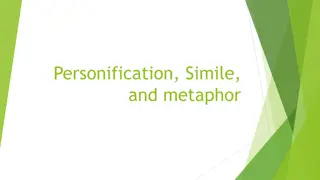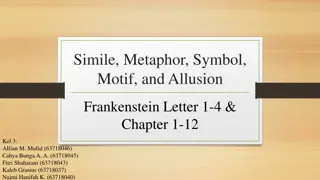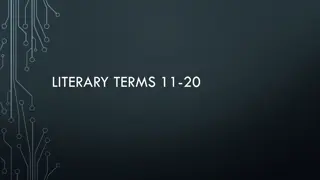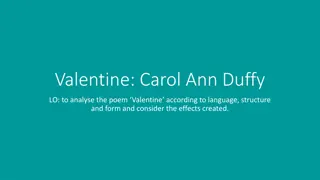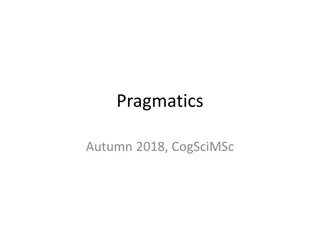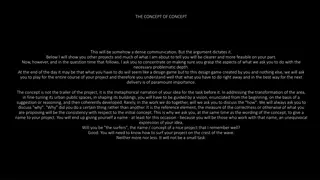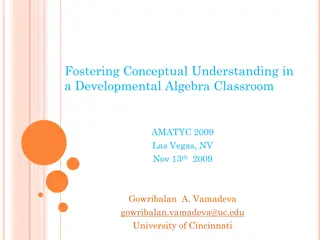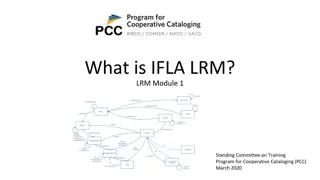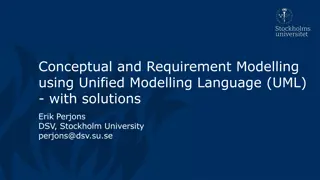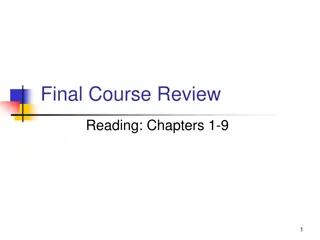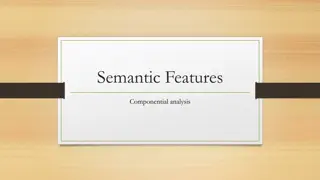Exploring the Conceptual Metaphor Theory: Enhancing Understanding Through Metaphors
Understanding the Conceptual Metaphor Theory involves grasping how metaphors enhance language expression and comprehension. By relating one conceptual domain to another, individuals can extend language usage beyond immediate experiences, allowing for unlimited expression. The theory's strength hinges on constructing a robust argument likened to building a theory as one would build a physical structure, emphasizing the foundational support, evidence, and plausibility. Correspondences between domains such as building foundations and theoretical bases illustrate the interconnectedness between different conceptual realms.
Uploaded on Sep 24, 2024 | 0 Views
Download Presentation

Please find below an Image/Link to download the presentation.
The content on the website is provided AS IS for your information and personal use only. It may not be sold, licensed, or shared on other websites without obtaining consent from the author. Download presentation by click this link. If you encounter any issues during the download, it is possible that the publisher has removed the file from their server.
E N D
Presentation Transcript
The conceptual metaphor theory Basic concepts and assumptions
By the use of metaphors the ability to understand and to express in language the experience of the world unbelievably increases. .
By the use of metaphors the ability to understand and to express in language the experience of the world unbelievably increases. It allows people to go beyond the immediate experience and to extend the language in an unlimited way. .
Conceptual metaphor Understanding one conceptual domain in terms of another conceptual domain.
Conceptual metaphor Understanding one conceptual domain in terms of another conceptual domain. A conceptual domain - any coherent organisation of experience. LIFE; LOVE; BEING SAD; LIGHT; ECONOMY; WAR, etc.
Conceptual metaphor Is that the foundation for your theory? The theory needs more support. We need to construct a strong argument for that. The theory will stand or fall on the strength of that argument.
Conceptual metaphor Is that the foundation for your theory? The theory needs more support. We need to construct a strong argument for that. The theory will stand or fall on the strength of that argument. THEORIES ARE BUILDINGS
Conceptual metaphor Is that the foundation for your theory? The theory needs more support. We need to construct a strong argument for that. The theory will stand or fall on the strength of that argument. THEORIES ARE BUILDINGS CONCEPTUAL DOMAIN (A) IS CONCEPTUAL DOMAIN (B)
Correspondences between domains SOURCE DOMAIN (BUILDING) TARGET DOMAIN (THEORY) the foundation of a building the basis of the theory support evidence strength plausibility construction creation collapse of a building fall of a theory
mappings There is a set of systematic correspondences or mappings between the source and the target. It means that constituent conceptual elements of the source correspond to constituent elements of the target.
ARGUMENT IS WAR Your claims are indefensible. He attacked every weak point in my argument. His criticisms were right on target. I ve never won an argument with him. If you use that strategy, he ll wipe you out.
TIME IS MONEY You re wasting my time. This gadget will save you hours. How do you spend your time these days? That flat tire cost me an hour. You don t use your time profitably.
LIFE IS A JOURNEY He s without direction in life. I m at a crossroads in my life. She s gone through a lot in life. He s gone (= died).
metaphor vs. metaphorical linguistic expression metaphor metaphorical linguistic expression Is that the foundation for your theory? Your claims are indefensible. You re wasting my time. THEORIES ARE BUILDINGS ARGUMENT IS WAR TIME IS MONEY LIFE IS A JOURNEY He s without direction in life.
Common source domains the human body (the heart of the problem) health and illness (a healthy society, she hurt my feelings) animals (a cow, a bitch) plants (the fruits of her labour, exports flourished) buildings and construction (he's in ruins financially) machines and tools (conceptual tools, she produces a book) games and sport (to toy with the idea) money and economic transactions (spending time, investing in a relationship) cooking and food (to cook up a story, a recipe for success) heat and cold (a cold reception, icy stare) light and darkness (a dark mood, a cloud of suspicion) forces (he's driving me nuts) movement and direction (he went crazy, inflation is soaring)
Common target domains emotion desire morality thought society/nation politics economy human relationships communication time life and death religion events and actions
Classification of metaphors conceptual metaphors are classified according to: conventionality cognitive function
Classification according to conventionality Conventional conceptual metaphors - well- entrenched ways of thinking about or understanding an abstract domain (often expressed by conventional linguistic expressions).
Classification according to conventionality Unconventional conceptual metaphors unconventional linguistic expression unconventional source-target connection
The cognitive function of metaphors Ontological metaphors Structural metaphors Orientational metaphors
The cognitive function of metaphors Ontological metaphors They give ontological status to abstract or vague concepts (i.e. we think and talk of them as if they were THINGS). They allow us to refer to, quantify, to identify more diffuse aspects of our experience.
The cognitive function of metaphors Ontological metaphors examples Give me a call. (an event is a physical object) my mind (a possessed physical object) in love (an emotional state is a container) Life has cheated me. (life is a person; personification) Ontological metaphors can be elaborated into structural metaphors.
The cognitive function of metaphors Structural metaphors Their cognitive function is to enable to understand the target by means of the structure of the source (by means of conceptual mappings). The source domain provides a relatively rich knowledge for the target concept.
The cognitive function of metaphors Orientational metaphors Their cognitive function is to make a set of target concepts coherent in our conceptual system. They are based on human spatial orientations (e.g. up-down, centre-periphery, etc.)
The cognitive function of metaphors Orientational metaphors MORE IS UP: Speak up, please. SICK IS DOWN: He fell ill. CONTROL IS UP: He is under my control. RATIONAL IS UP: The discussion fell to an emotional level.
Practice Identify source and target domains. Label the metaphor. 1. His ego is very fragile. 2. Inflation has robbed me of my savings. 3. He s rich in ideas. 4. She has a fertile imagination. 5. Life is empty for him. 6. My fear of insects is driving her crazy.
1. His ego is very fragile. THE MIND IS A BRITTLE OBJECT 1. Inflation has robbed me of my savings. INFLATION IS A PERSON 2. He s rich in ideas. IDEAS ARE MONEY 1. She has a fertile imagination. IDEAS ARE PLANTS 1. Life is empty for him. LIFE IS A CONTAINER 2. My fear of insects is driving her crazy. FEAR IS AN OBJECT. FEAR IS A FORCE.
The partial nature of metaphorical mappings which parts of the source are mapped onto which parts in the target When a metaphor focuses on one or some aspects of a target concept, then it highlights that concept (those concepts). The other aspects of the concept remain hidden (out of focus).
The partial nature of metaphorical mappings e.g. in the metaphor ARGUMENT IS A BUILDING we do not utilise many elements of the source such as doors, windows, living in, etc.
The partial nature of metaphorical mappings Several metaphors are used to structure the concept of argument: container metaphor highlights the content war control over the argument journey progress, content building construction, strength
Exercise What aspects of the source and target domains are utilised and highlighted in the metaphors of love below: LOVE IS A JOURNEY It s been a long bumpy road. Look how far we ve come. LOVE IS A NUTRIENT I m starved for love. LOVE IS A FIRE He is burning with love LOVE IS MAGIC I m under her spell.
Exercise What aspects of the source and target domains are utilised and highlighted in the metaphors of love below: LOVE IS A JOURNEY It s been a long bumpy road. Look how far we ve come. LOVE IS A NUTRIENT I m starved for love. LOVE IS A FIRE He is burning with love LOVE IS MAGIC I m under her spell. (progress)
Exercise What aspects of the source and target domains are utilised and highlighted in the metaphors of love below: LOVE IS A JOURNEY It s been a long bumpy road. Look how far we ve come. LOVE IS A NUTRIENT I m starved for love. LOVE IS A FIRE He is burning with love LOVE IS MAGIC I m under her spell. (progress) (desire)
Exercise What aspects of the source and target domains are utilised and highlighted in the metaphors of love below: LOVE IS A JOURNEY It s been a long bumpy road. Look how far we ve come. LOVE IS A NUTRIENT I m starved for love. LOVE IS A FIRE He is burning with love LOVE IS MAGIC I m under her spell. (progress) (desire) (intensity)
Exercise What aspects of the source and target domains are utilised and highlighted in the metaphors of love below: LOVE IS A JOURNEY It s been a long bumpy road. Look how far we ve come. LOVE IS A NUTRIENT I m starved for love. LOVE IS A FIRE He is burning with love LOVE IS MAGIC I m under her spell. (progress) (desire) (intensity) (loss of control)
The concept of sadness: an analysis Identify the conceptual metaphors manifested by these examples. Which aspects of sadness are highlighted and which aspects are hidden? Waves of depression came over him. He brought me down with his remarks. He is in a dark mood. I am filled with sorrow. That was a terrible blow. Tim heals all sorrows. He was insane with grief. He drowned his sorrow in drink. His feelings of misery got out of hand. She was ruled by sorrow.
Waves of depression came over him. SADNESS IN A NATURAL FORCE Highlighted: passivity, lack of control Hidden: cause, attempt at control, behavioural responses (?)
He brought me down with his remarks. SAD IS DOWN Highlighted: negative character Hidden: cause, attempt at control
He is in a dark mood. SAD IS DARK Highlighted: negative character Hidden: cause, attempt t control
I am filled with sorrow. SADNESS IS A FLUID IN A CONTAINER Highlighted: intensity, attempt at control, loss of control Hidden: negative character
That was a terrible blow. SADNESS IS A PHYSICAL FORCE Highlighted: passivity, sudden impact Hidden: cause, attempt at control, behavioral responses
Tim heals all sorrows. SADNESS IS A DISEASE Highlighted: negative character, passivity, behavioral responses Hidden: attempt at control
He was insane with grief. SADNESS IS INSANITY Highlighted: lack of control Hidden: attempt at control
He drowned his sorrow in drink. SADNESS IS AN OPPONENT Highlighted: attempt at control Hidden: passivity
His feelings of misery got out of hand. SADNESS IS A CAPTIVE ANIMAL Highlighted: loss of control Hidden: passivity
She was ruled by sorrow. SADNESS IS A SOCIAL SUPERIOR Highlighted: lack of control Hidden: attempt at control
